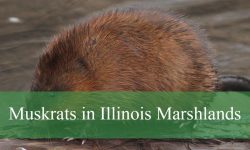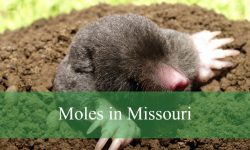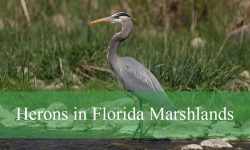Florida’s lush landscapes are home to a surprising variety of caterpillars, some of which are beautiful yet dangerously venomous. While they play an important role in nature, their stings can cause painful reactions for people who encounter them.
From the furry puss caterpillar to the brightly marked saddleback, these insects use venomous spines or irritating hairs as a natural defense. Many are found on common shade trees, fruit trees, and ornamental plants, making accidental contact fairly common.
Learning how to recognize these caterpillars is the best way to stay safe. This guide explores seven poisonous caterpillars in Florida, highlighting their unique features, habitats, and the potential risks they pose.
Types of Poisonous Caterpillars Found in Florida
Puss Caterpillar (Megalopyge opercularis)
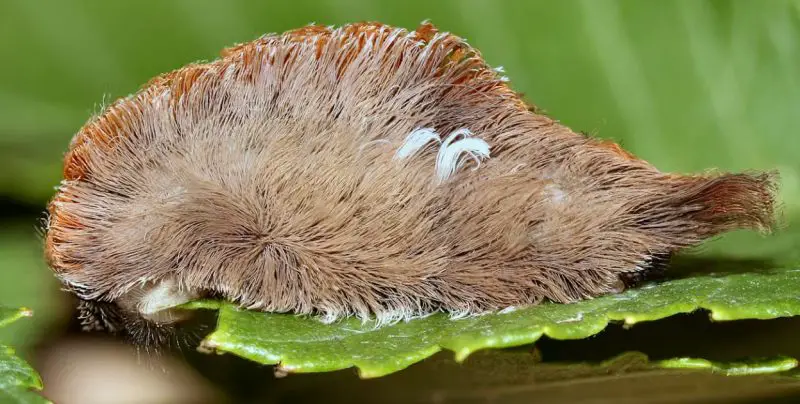
The puss caterpillar, also known as the asp caterpillar, is considered the most venomous caterpillar in the United States. It has a distinctive, furry appearance that makes it look more like a tiny Persian cat than an insect. Beneath its long, silky hair-like setae are hidden venomous spines that can penetrate human skin upon contact. These spines inject a potent toxin that causes intense, burning pain, often compared to a broken bone or severe burn.
Adult puss caterpillars grow about 1 to 1.5 inches in length. Their bodies are typically gray to brown, with the thick coat of hairs giving them a deceptively soft and harmless look. The hair conceals sharp spines that act as hypodermic needles, delivering venom when touched. This appearance is one reason why they often catch people off guard, especially children and gardeners.
Puss caterpillars are found throughout Florida, especially in the southern regions, but they also appear in other warm, humid states. They are typically associated with shade trees, shrubs, and ornamental plants in residential areas. Common host plants include oak, elm, sycamore, citrus, and various ornamental shrubs. They often remain well camouflaged against foliage, making accidental contact more likely.
The venom of the puss caterpillar causes severe localized pain, swelling, nausea, and in some cases systemic reactions requiring medical treatment. The sting site may develop a red grid-like pattern, a diagnostic feature of their venomous spines. Due to their dangerous sting, people are advised never to handle these caterpillars, even though their “furry” look might seem inviting.
Io Moth Caterpillar (Automeris io)
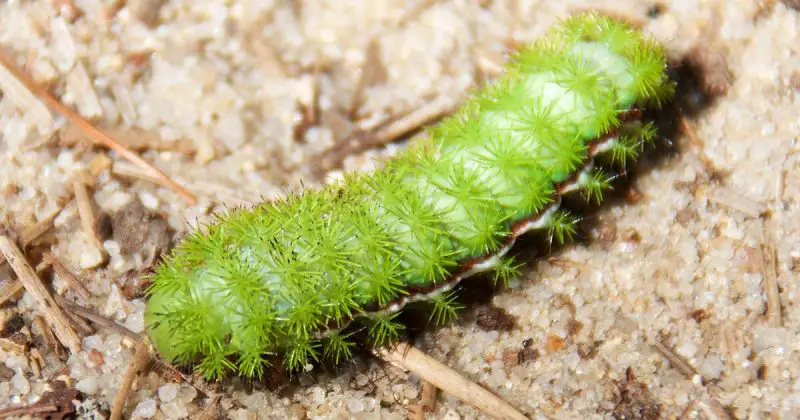
The Io moth caterpillar is a large, striking species that undergoes dramatic changes throughout its development. Early instars are dark and clustered, while later instars become bright green with a prominent red-and-white lateral stripe. Its body is covered in numerous branched, venomous spines that are capable of delivering a painful sting when touched. These stings can cause burning, itching, and localized swelling.
Mature Io moth caterpillars can reach up to 2.5 inches in length. Their bright coloration serves as a warning to predators that they are not safe to eat. The spines along their body are tipped with hollow setae connected to venom glands. When brushed against skin, they break off easily and inject venom, causing discomfort that can last from several hours to a full day.
In Florida, Io moth caterpillars are commonly found in both natural woodlands and suburban areas. They have a wide range of host plants, including hibiscus, elm, oak, hackberry, redbud, willow, and roses. Their adaptability to ornamental plants makes them a common sight in gardens, where encounters with humans become more likely.
These caterpillars are active from late spring through fall, depending on climate conditions. Their stings are rarely life-threatening but can be very painful, especially for children or individuals with sensitive skin. The adult moths are large and colorful, but it is the caterpillar stage that poses the danger.
Saddleback Caterpillar (Acharia stimulea)
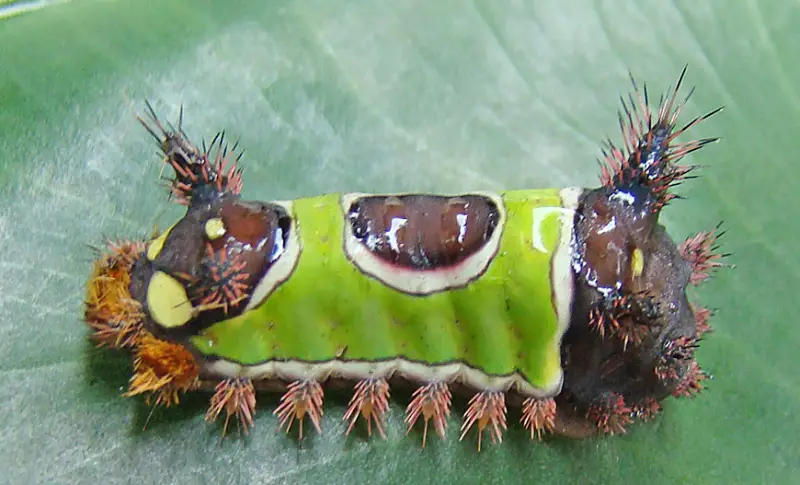
The saddleback caterpillar is one of the easiest poisonous caterpillars to identify due to its unique appearance. Its body is mostly green with a brown front and rear, and a large, square-shaped brown patch in the middle bordered by a white outline, resembling a saddle blanket. This distinct “saddle” marking makes it stand out among other caterpillars. Surrounding its body are clusters of venomous spines that can inflict painful stings.
Fully grown saddleback caterpillars reach about 1 inch in length. The spines along their sides, tail, and horn-like projections at both ends are sharp and hollow, capable of breaking off and embedding in human skin. The sting delivers venom that causes intense pain, burning, swelling, and sometimes nausea or headaches in more sensitive individuals. The saddleback’s bold coloration also acts as a natural warning to predators.
This species is widely distributed throughout Florida and thrives in wooded areas, fields, gardens, and ornamental landscapes. It feeds on a wide range of host plants, including corn, roses, hibiscus, asters, and many fruit trees. Because of its diverse diet, the saddleback can appear in both agricultural fields and residential backyards.
Encounters with saddleback caterpillars are common during summer and fall, when they are most active. Their sting is often compared to that of a bee or wasp, but in some cases, the reaction can be more severe, with welts and rashes lasting for several days. For this reason, they are regarded as one of Florida’s most notorious stinging caterpillars.
Hag Moth Caterpillar (Phobetron pithecium)
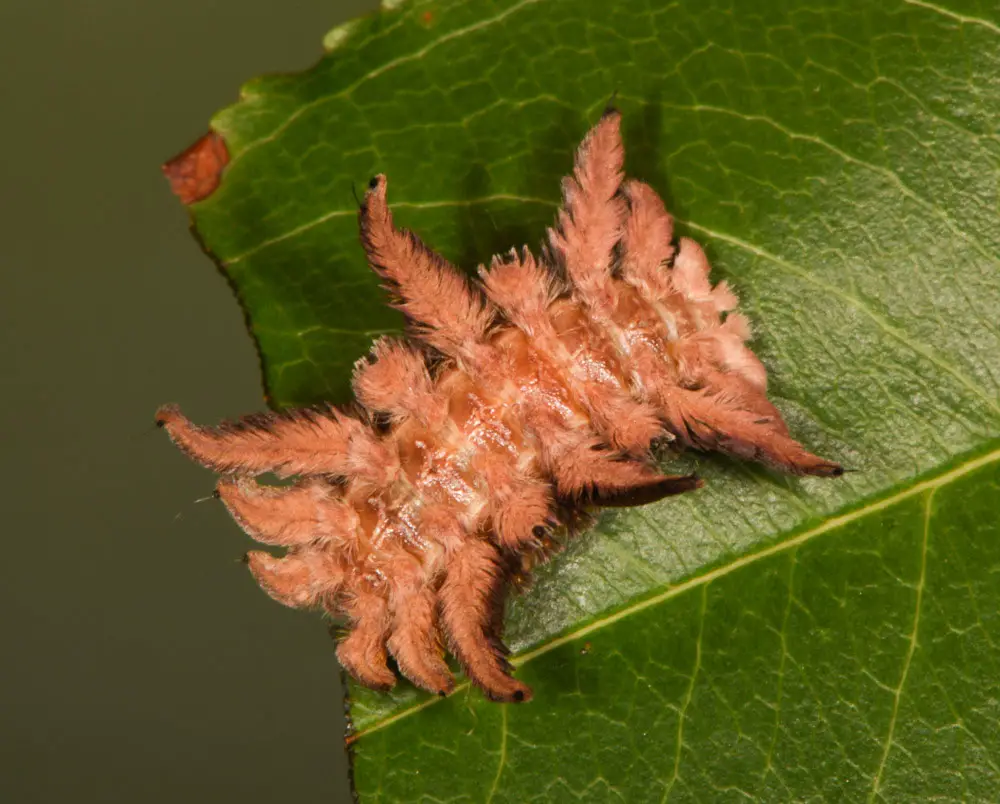
The hag moth caterpillar, often called the monkey slug, is one of the strangest-looking caterpillars in Florida. Its body is brown and hairy, with several arm-like projections that resemble the legs of a crab or spider. This unusual shape provides excellent camouflage, making it look like a piece of dried leaf or debris. Despite its odd appearance, it is a stinging caterpillar with venomous spines hidden among the hairs.
Adult hag moth caterpillars typically measure about 1 inch in length. The “arms” that branch out from its body are covered with stiff hairs, some of which contain venom. When touched, the spines can break off and penetrate human skin, releasing toxins that cause irritation, redness, and burning pain. Although not as severe as the sting of the puss caterpillar, the discomfort can still last for several hours.
This species is found throughout Florida in shaded forests, gardens, and areas with abundant shrubs and trees. It commonly feeds on oak, chestnut, persimmon, dogwood, and apple trees. Its excellent camouflage makes it difficult to spot, and most people encounter it accidentally while handling leaves or branches.
The hag moth caterpillar is active from summer through early fall. Its sting is generally not life-threatening but can cause significant pain, particularly in children or those with sensitive skin. Because of its unusual form and venomous defense, it is often considered one of Florida’s most fascinating yet dangerous caterpillars.
Buck Moth Caterpillar (Hemileuca maia)
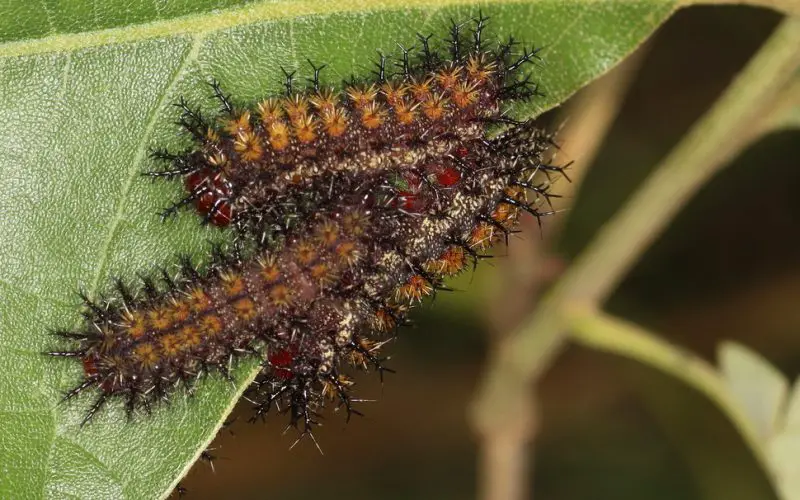
The buck moth caterpillar is a large, dark-colored species covered with branching spines capable of delivering a painful sting. Unlike some other stinging caterpillars that are small and inconspicuous, the buck moth caterpillar grows up to 2.5 inches in length, making it one of the larger venomous caterpillars in Florida. Its body is typically black or deep brown, with white spots and rows of spines that stand out clearly against its dark background.
The spines of this caterpillar are hollow and connected to venom glands, releasing toxins when they come into contact with skin. The sting can cause immediate burning, swelling, and redness. In some cases, multiple stings from groups of caterpillars feeding together can result in stronger reactions, including nausea and headaches.
Buck moth caterpillars are most often found in oak forests, pine barrens, and mixed woodlands throughout Florida. Oaks are their preferred host plant, especially live oaks and scrub oaks, which are abundant in the state. Because of their communal feeding habits, they are often seen in large numbers, making encounters more likely when people are hiking or working outdoors.
These caterpillars are most active in late spring and early summer. While their sting is painful, it rarely leads to long-term medical problems. However, because they can occur in groups, caution is advised when spending time under oak trees during their active season.
Spiny Oak-Slug Caterpillar (Euclea delphinii)
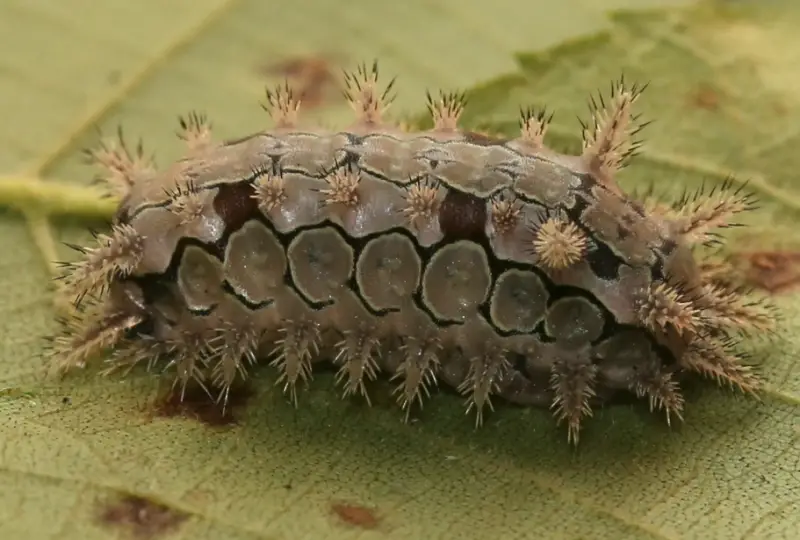
The spiny oak-slug caterpillar is a small but brightly patterned species that carries a powerful sting for its size. Its body can be a mix of green, orange, yellow, and brown, often with intricate designs that act as a warning to predators. Despite growing only about 1 inch in length, this caterpillar is heavily armed with stinging spines arranged along its back and sides.
The venomous spines of the spiny oak-slug caterpillar cause immediate pain when touched, followed by redness, itching, and swelling. In sensitive individuals, the sting may also trigger headaches, nausea, or more widespread irritation. Because of its small size and tendency to blend into foliage, it often surprises gardeners or hikers who brush against leaves unknowingly.
As its name suggests, the spiny oak-slug caterpillar is commonly found on oak trees throughout Florida. However, it also feeds on a wide range of host plants, including cherry, chestnut, hickory, willow, and ornamental shrubs. Its adaptability allows it to thrive in woodlands, gardens, and residential landscapes alike.
The species is active during the warmer months, particularly summer and early fall. Though its sting is not as severe as that of the puss caterpillar, it can still cause significant discomfort, especially when multiple caterpillars are present. Its vivid coloration is both beautiful and dangerous, serving as a warning to avoid contact.
White-Marked Tussock Moth Caterpillar (Orgyia leucostigma)
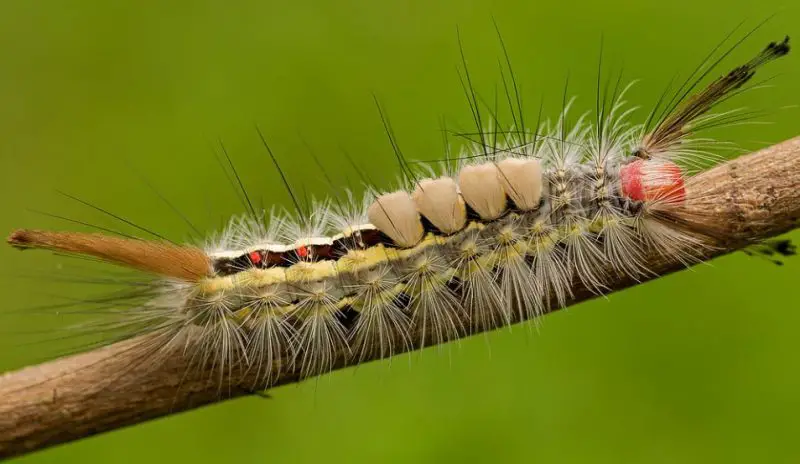
The white-marked tussock moth caterpillar is one of the most distinctive species in Florida, recognized by its bright red head, long black hair pencils at both ends, and four white toothbrush-like tufts of setae along its back. This striking combination of features makes it easy to identify compared to other stinging caterpillars. While not as venomous as some species, its hairs can still cause skin irritation in humans.
This caterpillar typically grows to about 1.5 inches in length. Its bright warning colors and unusual tufts serve as a deterrent to predators. The hairs are barbed and can break off when touched, embedding in human skin and causing itching, redness, and mild rash. While its sting is not considered medically dangerous, it can still be very unpleasant, especially for children.
The white-marked tussock moth caterpillar is widespread in Florida and feeds on a wide range of host plants. Common trees include oak, hickory, elm, maple, birch, and fruit trees such as apple and cherry. Because of this broad diet, it often appears in gardens, orchards, and residential areas.
These caterpillars are most active from late spring through summer. While their sting is relatively mild compared to species like the puss or saddleback caterpillar, large infestations can increase the risk of accidental contact. They are also considered pests due to their appetite for ornamental and shade trees, sometimes causing noticeable defoliation.
Safety Precautions and Final Notes on Poisonous Caterpillars in Florida
Florida’s warm and humid climate provides an ideal environment for a variety of caterpillar species, including some of the most venomous ones in North America. While their unique colors, shapes, and hairy appearances may make them fascinating to observe, they pose a real risk when handled. Many of these caterpillars rely on venomous spines or irritating hairs as a defense mechanism against predators, and unfortunately, accidental human contact can result in painful reactions.
To stay safe, it is best to avoid touching any hairy or brightly colored caterpillar you encounter. Gardeners, children, and outdoor workers are particularly at risk since these caterpillars are often found on common shade trees, fruit trees, and ornamental plants. Wearing gloves when gardening, pruning, or collecting leaves can greatly reduce the chances of being stung. Additionally, teaching children not to handle fuzzy caterpillars is an important preventive measure.
If contact with a poisonous caterpillar does occur, the first step is to carefully remove any remaining spines from the skin using adhesive tape or tweezers. Washing the affected area with soap and water helps reduce irritation, and applying ice packs or antihistamine creams may ease pain and swelling. For severe reactions—such as intense pain, widespread rash, difficulty breathing, or nausea—medical attention should be sought immediately.
Although these stinging caterpillars can cause discomfort, they play an important role in Florida’s ecosystems. They eventually transform into moths or butterflies, contributing to pollination and serving as part of the natural food chain. By respecting their space and exercising caution, people can appreciate their presence in nature without falling victim to their painful defenses.
FAQs about Poisonous Caterpillars in Florida
What is the most poisonous caterpillar in Florida?
The puss caterpillar (Megalopyge opercularis) is the most poisonous caterpillar in Florida and the United States. Its furry appearance hides venomous spines that can cause excruciating pain, burning, swelling, and even systemic symptoms like nausea or difficulty breathing in sensitive individuals.
Where are poisonous caterpillars commonly found in Florida?
Poisonous caterpillars in Florida are most often found on shade trees, fruit trees, and ornamental plants. Oaks, elms, sycamores, citrus, hibiscus, roses, and various shrubs are common host plants. They are present in forests, suburban neighborhoods, gardens, and parks, making encounters possible in both natural and residential areas.
When are poisonous caterpillars most active in Florida?
Most stinging caterpillars in Florida are active during the warmer months, from late spring through fall. Species such as the saddleback and spiny oak-slug caterpillar are especially common in summer, while the puss caterpillar may be found year-round in southern Florida due to the consistently warm climate.
What should I do if I get stung by a caterpillar?
If stung, carefully remove any embedded spines using tape or tweezers. Wash the area with soap and water, then apply ice packs or antihistamine creams to relieve pain and swelling. For severe reactions, including breathing difficulties, chest pain, or widespread rash, seek immediate medical care.
Can poisonous caterpillars in Florida be dangerous to pets?
Yes, pets such as cats and dogs can also suffer from painful stings if they come into contact with venomous caterpillars. Symptoms may include paw licking, swelling, or unusual behavior. If a pet is suspected of being stung, it is best to consult a veterinarian promptly.
Are these caterpillars invasive or native to Florida?
Most poisonous caterpillars in Florida, including the puss, saddleback, and buck moth caterpillars, are native species. They are natural components of the ecosystem and eventually become moths that contribute to pollination and serve as food for birds and other wildlife.

